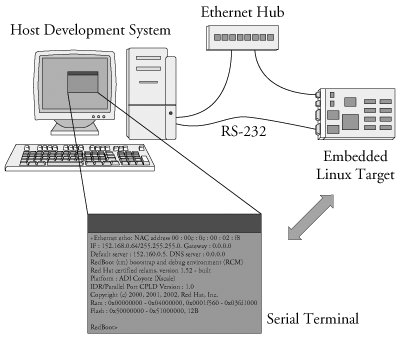Книга: Embedded Linux Primer: A Practical, Real-World Approach
2.2.1. Typical Embedded Linux Setup
2.2.1. Typical Embedded Linux Setup
Often the first question posed by the newcomer to embedded Linux is, just what does one need to begin development? To answer that question, we look at a typical embedded Linux development setup (see Figure 2-2).
Figure 2-2. Embedded Linux development setup

Here we show a very common arrangement. We have a host development system, running your favorite desktop Linux distribution, such as Red Hat or SuSE or Debian Linux. Our embedded Linux target board is connected to the development host via an RS-232 serial cable. We plug the target board's Ethernet interface into a local Ethernet hub or switch, to which our development host is also attached via Ethernet. The development host contains your development tools and utilities along with target filesnormally obtained from an embedded Linux distribution.
For this example, our primary connection to the embedded Linux target is via the RS-232 connection. A serial terminal program is used to communicate with the target board. Minicom is one of the most commonly used serial terminal applications and is available on virtually all desktop Linux distributions.
- 2.2. Anatomy of an Embedded System
- 8.5.2 Typical Condition Variable Operations
- InterBase Classic Server под Linux
- Каталог BIN в InterBase Classic Server для Linux
- Chapter 16. Commercial products based on Linux, iptables and netfilter
- Using Double Quotes to Resolve Variables in Strings with Embedded Spaces
- Kernel setup
- User-land setup
- 1 Введение в Linux
- 4 Файловая система Linux
- З.1. BIOS Setup
- 1.2. Что такое Linux?




